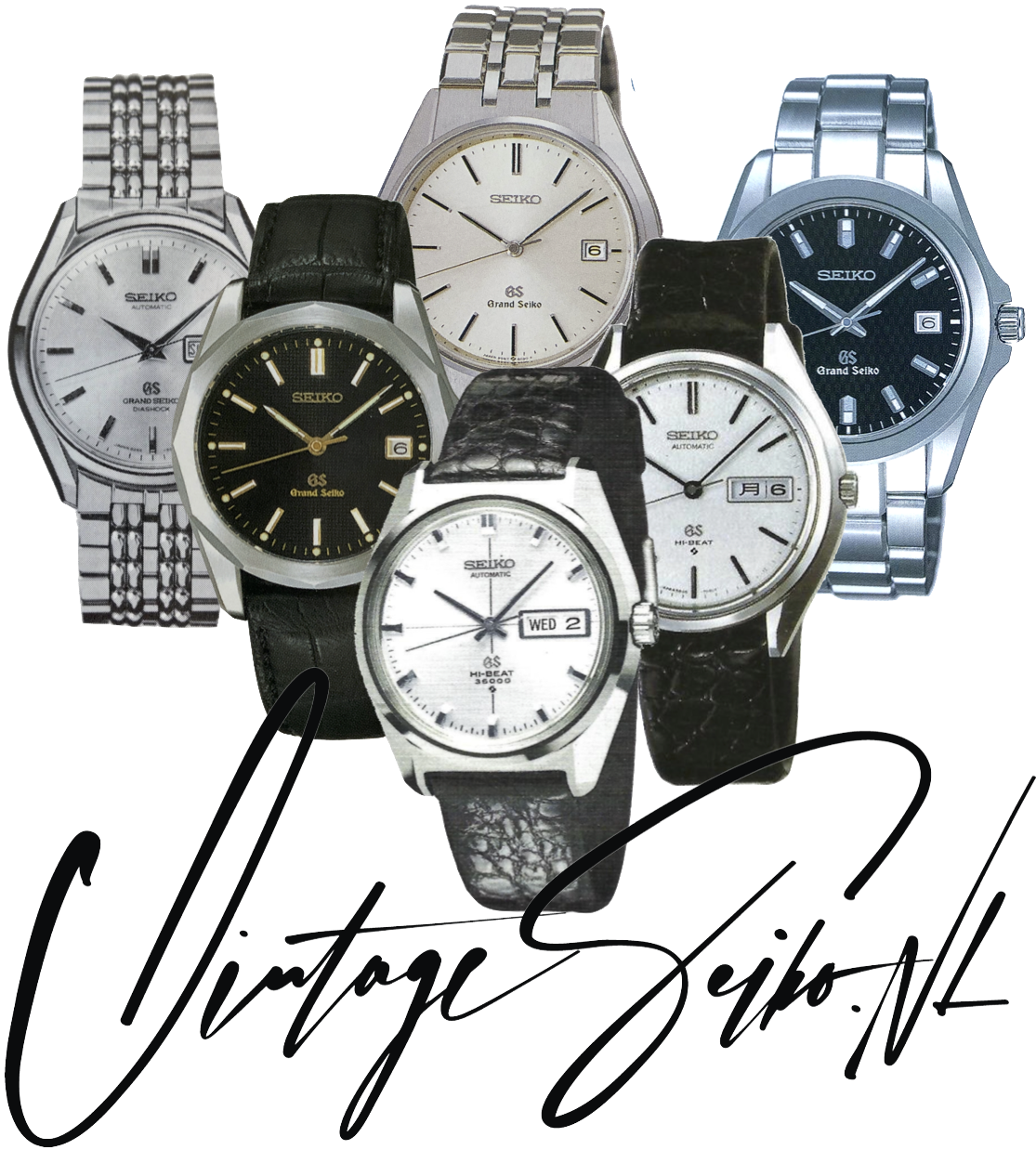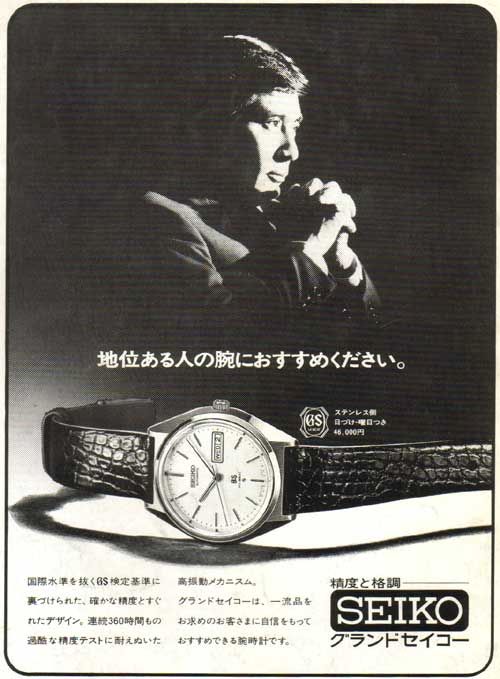In 1988 the caliber 9581 and the 9587 was Seiko’s first forage into GS territory after the GS brand was abandoned in the early seventies, as the Grand Quartz was in 1980 - but not the Superior.
There are too many GS models to get into here so let us just pay homage to the last of the vintage Grand Seiko - the range of the 56GS series. The 56 contained no “special” or “VFA” examples - but there are 35 different models produced from 1970 until 1974! It was an effort to keep up with the quartz proliferation. Ironically of Seiko’s own making. Below is just the line-up from 1974.

A Grand in Gold
The Seiko Grand Quartz first appeared with four models in the 1975 Japanese Domestic Market (JDM) catalogue, in white and yellow gold only. One should not mix these up with the Quartzes of 1974, the 38SQW V.F.A, 39SQW V.F.A or 38QTW, 39QTW, -QRW, QRC, QT etc. Prices of these would vary… but the classic automatic Grand Seiko was initially depicted in the ’74 catalogue as cheaper, as separate and to the lower right of the new fangled quartzes! These quartzes developed at a frenetic pace, in all four different GQ caliber series were introduced. The 48, 92, 94 and 99 series.
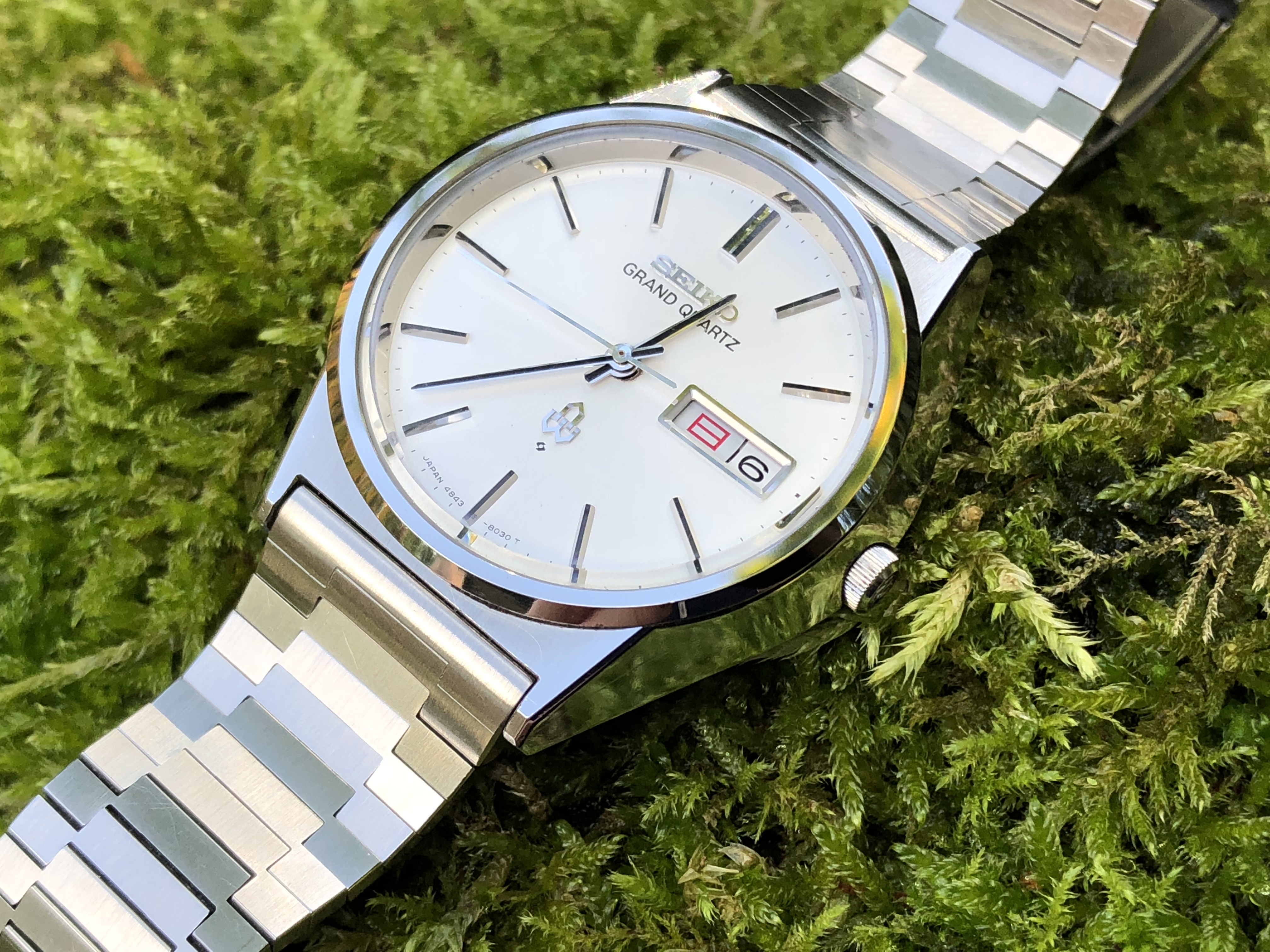
The 48xx was a very solidly made quartz with a production span of just four years. In the first year of its production in 1975, only this Grand Quartz reigned supreme right next to the Quartz V.F.A with just three models, 8000/8010/8020, there were no other GQ calibers! The models 8030/8040 were introduced later in 1975 and made for just three years; they came with a thick steel band for the 4843 and with leather only for the 4840 & 4842. That setup never changed for this caliber. Even when the much daintier 48xx-8110 variation was introduced in 1977, ending the 8030/8040 production run in that year.
In 1978 Seiko introduced the twin quartz 9943, ending all of the 48xx caliber that year. The 48xx of the year before however remained a thicker and wider flaring watch (38x43x11mm!) and was more robust than its 9943 descendant - it was after all a Tanaka design.
Thirty-five fifty-six G’s
Even so, not withstanding the fact that these Grand Quartz movements were mass produced early on and sold (until 1980), the 56GS hobbled along, also mass produced. And 40 years after its production this last automatic GS still is the most reliable “workhorse” of all, with readily available maintenance parts even now! Of course, a slightly less finely tuned caliber 56 movement was also used in the King Seiko 562x series and the Lord-matics 560x, making it a universal favorite at the luxury top end of the market.
In this then Seiko’s design concept was successful, for Grand Seiko was to be the “ideal watch,” which meant “nothing less than the best luxury watch in the world." For the company, this meant the Grand Seiko should have its own unique style that would resonate with the high-end market. Specifically, Seiko wanted the Grand Seiko’s style to suit both casual and formal attires. As can be seen in the 1971 line-up.
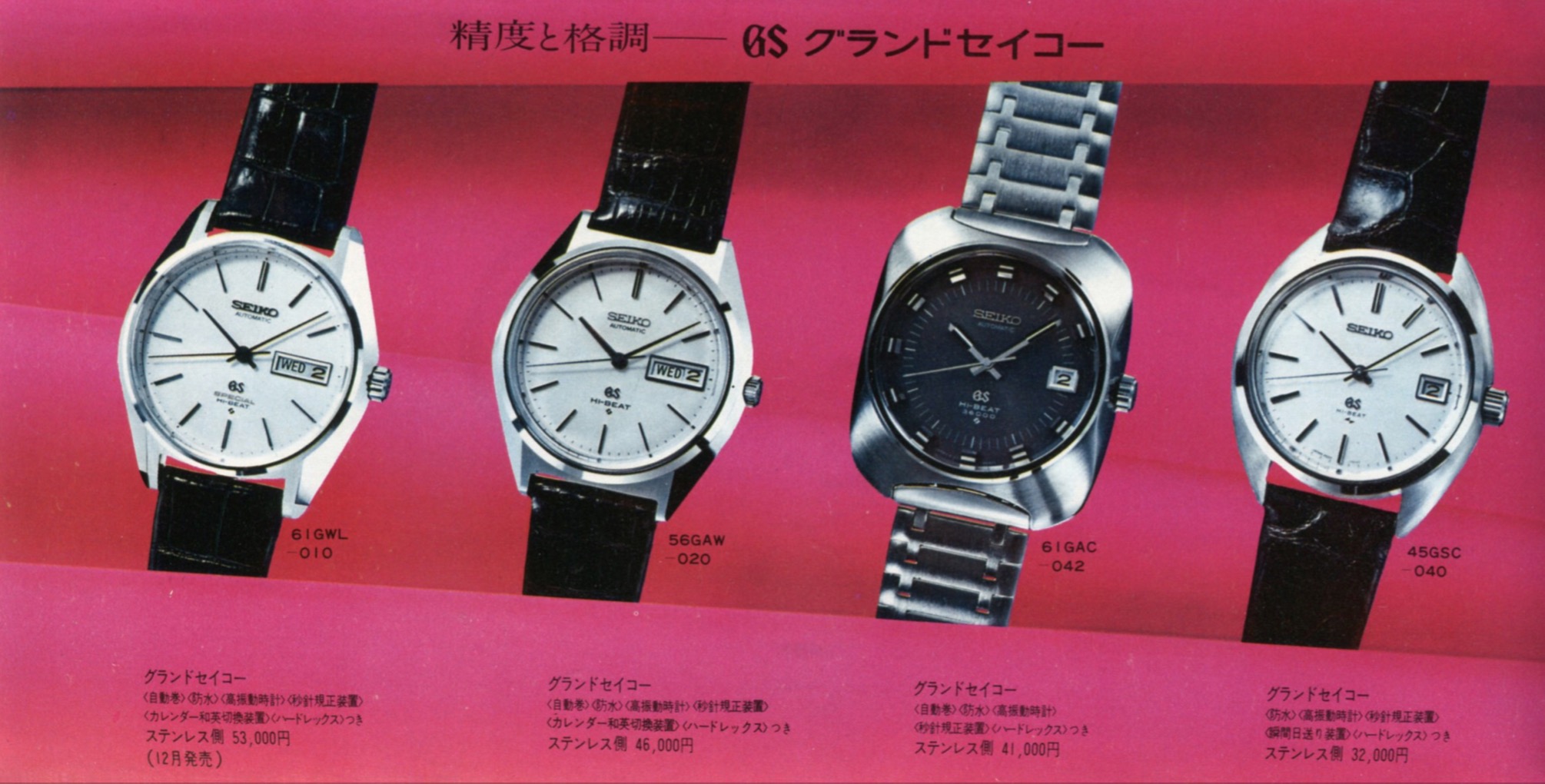
When the original Grand Seiko was created in 1960 by the company’s Suwa Seikosha division, its focus was on quality mechanics. It wasn’t until 1967 when the 44GS movement was released that the “Grand Seiko Style” by designer Taro Tanaka would from then on define the series as well as all future Seiko products.
The Grand Seiko range is of course also highly valued for its craftsmanship, particularly the traditional way in which the watches are created. Every Grand Seiko watch was polished by hand using the “Zaratsu” technique. This is a traditional Japanese way of "tin wheel polishing" used to create watches that have a mirror finish with no distortion. This happened to be the perfect extension of Tanaka’s iconic design ideas.
Tough Teams
The Suwa Seikosha division produced most of these Grand Seiko watches, except for the 44GS, 45GS, and 45GS VFA movements, which were created by its Daini Seikosha division. The two companies were Seiko’s subsidiaries which produced one brand to improve technology and hedge risk amid tough competition. If one experienced problems in production, the other would simply increase production.
Of the famous hand finished 61GS line for example, released in December 1967, Seiko created just 36,000 units. The 61GS movement is one of Seikos finest, a 25 jewel automatic hi-beat that operates at 36,000bph, made at their Suwa factory. It can also be wound manually, and has a hacking feature. It is finished to a high level, with a nicely decorated rotor. The 61GS movement achieved the Seiko internal GS standard approval, which was adjusted to be within -3/+5 sec/day when it left the factory.
The early 614X-8000 model had Grand Seiko written on the dial, which was marked 8000TAD at 6 o'clock. The movement was marked 614XA and both GS (sometimes) and Grand Seiko on the rotor. There was a gold cap version of this model also. Later models had automatic under Seiko and also dispensed with Grand Seiko and had Hi Beat 36000 instead, and 8010TAD at the bottom of the dial. The rotor was marked Seiko.
However, no fewer than eight distinct models have the same 6145-8000 code. And there are differences between these models, both with respect to dial design and case material. The full list of these models, along with the year of their introduction, and original prices, is as follows:
Stainless steel -8000 case; early Grand Seiko marked dial; supplied on a leather strap; 1968; 37,000 Yen
Stainless steel -8000 case; later Hi-beat marked dial; supplied on a leather strap; 1969; 37,000 Yen
Stainless steel -8000 case; later Hi-beat marked dial; supplied on a bracelet; 1970; 40,000 Yen
Cap gold -8000 case; early Grand Seiko marked dial; supplied on a leather strap; 1968; 45,000 Yen
Cap gold -8000 case; later Hi-beat marked dial; supplied on a leather strap; 1969; 45,000 Yen
18K gold -8000 case; later Hi-beat marked dial; supplied on a leather strap; 1969; 190,000 Yen
Stainless steel -8000 case; Cross dial; supplied on a leather strap; 1969; 37,000 Yen
Stainless steel -8000 case; Cross dial; supplied on a bracelet; 1970; 40,000 Yen
The third digits
To put a twist on the above list one might consider the third digit of the 61GS movement code, which will be a “4”, “5,” or an “8”. It is used to identify the quality. Simply put, the higher the number, the more accurate the movement. With Grand Seiko there is always good, better best. But for each buyer there is a grail watch, design oriented like the cross hair models or from a horological chronometry perspective like "the third digits".
So, after two decades has passed Seiko was still adhering strongly to the “Grammar of Design” rules set by Tanaka, but with the 9587 series Seiko dropped the Grand Quartz brand in favour of Grand Seiko, with GS on the dial no matter if the watch was quartz or automatic. In reviving GS primarily as a quartz collection it was imperative that the Japanese Manufacture develop a Voltage Compensated Temperature Compensated Crystal Oscillator (VCTCXO) module, which features both thermo-compensation and a rate trimmer. It would have to live up to the GS name and standard.
The 9587/1 then is a great watch with nostalgic design, even if slightly small for today’s taste. Its movement is a Seiko Quartz Cal 958xA, with 7 Jewels, 32.768 Hz, thermal compensation, anti-magnetic, accuracy: +/- 10 sec/year, 3-year battery life. It is one of the very few Seiko watches that uses a 17mm lug width. This GS is one of the world’s most accurate watches even today, 20 years later. It is also one of the cheapest ways to get a GS.
The outcome of this endeavor was a quartz module that was larger and more robust than previous “thin” Seiko high end quartzes, housed in practical but iconic (Tanaka) case design and with dials that have been uniquely Grand Seiko ever since.
The 9581A, later re-designated 9F81, is equipped with a unique Twin Pulse Control high-torque stepper motor which makes each second hand movement in two fluid pulses to reduce energy consumption. Instantaneous date change occurs over just 0.5 milliseconds, while a backlash auto-adjustment mechanism eliminates stepper error. Furthermore, the movement module is air-tight, ensuring the stepper rotor and lubricants are protected from particles of dust. This last feature maintains optimal performance for an estimated period of 50 years before requiring a service! But this is nothing new to vintage Seiko collectors, most 70s quartzes still function without problems.
One cannot ignore, to put it in a nutshell, that the GS Quartz is the true carrier of the original ideal of GS, and arguably more so than modern mechanical GS. Owning a GS Quartz is by its very essence, owning the timepiece with the Grand Seiko ideals, the carrier of the original torch of precision.
In 1992, the last year of 9581 production, the GS line was not only continued by its descendant the 9F81 movement but also extended by the legendary caliber 8J. The quality of this movement as compared to 9F can be easily expressed by the graph below.
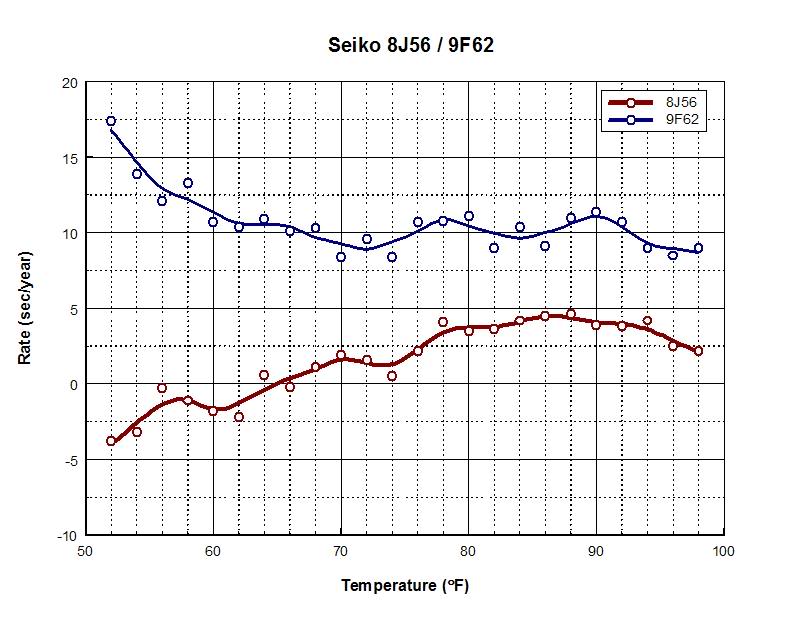
Legendary movement
Grand Seiko SBGF, and the 8J movement in general was produced from 1997 to 2011 (as far as can be established). It is considered by Seiko to be one of the best quartz movements ever produced, much better than the equally well known 9F and much more stable and accurate. It was expensive to produce and parts of the design made it hard to fit into thinner cases. The more cost effective 9F movement on the other hand is less stable, not so resistant to temperature and magnetic fields and costs about 30 percent less to produce than the 8J. But, importantly, it is thinner, and uses more common parts, therefore the frame can be used for a number of other movements and watches.
However, the 8J is, without a doubt, the most robust high accuracy quartz movement ever made. Even the fact that it had to be thicker works in its advantage, resulting in even better thermo compensation performance.
The information coming from internal specs from Seiko in Japanese, on the 8J and 9F movements, is universal, saying the 8J was the last “cost be damned” very robust movement made. The internal feeling is the 9F is less robust, less accurate, less shielded, and, yes, some of them scoff at the lack of an independent hour hand with which one easily adjusts to other time zones on the 8J.
Of course, the very high accuracy +- 5 second twin quartz movements of the seventies were extremely expensive to produce, for example a “simple” steel edition of the Superior at 3200 Euro, but these were not robust in field use. This was evidenced by a rather charming anecdote.
In Japan these high end watches were of course worn by well groomed businessmen. Their biggest problem was two fold, they needed the correct time at all times and they needed to catch the train straight from their bath house relaxation/happy hour. But, these watches tended to get fried if worn in hot baths or shower rooms - a real issue - the harried salary man must have his watch with him in the Sauna to benchmark the last train! The 8J was the answer to those concerns..
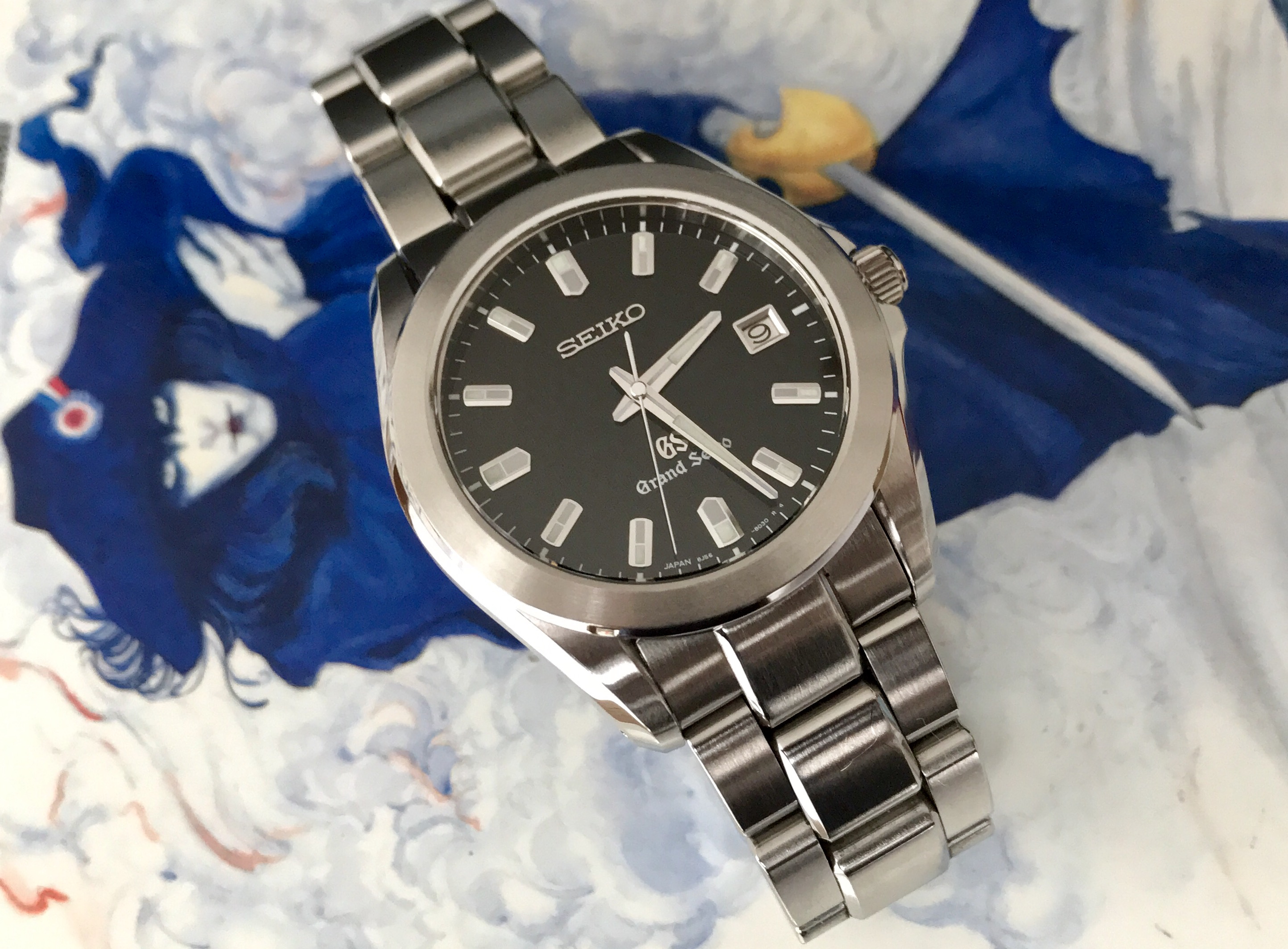
This 8J Grand Seiko SBGF021 harks back nostalgically to design characteristics of the seventies, most obviously the shape of the case. It is very reminiscent of Seiko’s crazy days, especially in the way in which the crown side is designed. It is just like some King Seiko Vanacs, but more distinguished. Also, the three dimensional dial design of those watches is present here, caused by applying the indexes, the SEIKO and the GS logo to an absolutely stunning effect. The hands are of course baton style, and even the seconds hand is the pencil of old. The minute match up (pun intended) of these design elements is typically Seiko, the hands at their center are about as thick as the hour indices, and where the minute hand meets up with the indices it overlaps just the raised part of it. Just great! And the seconds hand is the same width as the minute indices…
L’histoire se répète..
Well, let us not get into it right here and now, but just conclude that for some aficionados the most disturbing and distracting aspect of “modern” Grand Seikos is a mismatch of the aforementioned design choices. They just do not attain the perfect harmony of an old school Grand Seiko or even Grand Quartz. Seiko itself seems to have realized this when they started reissuing the most iconic Grand Seikos in their Historical Collection. Now seikoholics can buy their 44s, 62s and what not in mint condition! It will cost you of course.. Maybe go vintage again?
